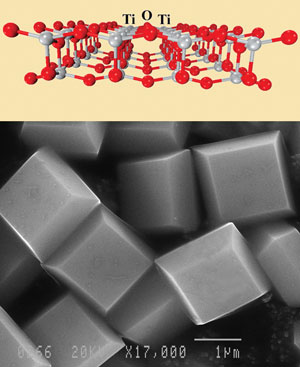博文
Changing the face of a water splitting catalyst
|


Changing the face of a water splitting catalyst
Australian chemists have grown crystals of the water-splitting catalyst titanium dioxide that are many times more reactive than usual.
Anatase,one of the three crystal forms of titanium dioxide, can act as aphotocatalyst that splits water into hydrogen and oxygen in thepresence of sunlight. But harnessing this potentially abundant energysource still presents many challenges.
The new crystals -which are more than five times more effective at splitting water thanunmodified anatase - were made by adjusting the crystal structure onthe surface of the crystals. These surfaces, known as facets, typicallyform in the most thermally stable configuration, designated {101},which contains mostly 6-coordinate titanium atoms.
However, analternative surface configuration called {001} where most of thetitanium atoms are only 5-coordinate, has been found to be far morereactive. 'The high percentage of "unsaturated" titanium atoms in {001}allows stronger interactions with adsorbed molecules, such as water,resulting in a surface that is many times more reactive,' explains MaxLu, the leader of the team at the University of Queensland, Australia.
Theteam used computer simulations to reveal that the formation of {001}facets could be directed using dilute hydroflouric acid, whichterminates the growth of the crystal at the surface. This process,explains Lu, makes the {001} facet more thermodynamically favourableand allows it to form preferentially. After the crystals have formed,any residual fluorine can easily be removed by heating in an ovenwithout affecting the crystal structure.
The team demonstratedtheir results by making crystals at a uniform size of about onemicrometre. Whereas only a few percent of the facets innaturally-occurring anatase crystals are the more reactive {001} kind,around 50 per cent of the facets in the new crystals are of this type.
'Thiswork demonstrates a beautiful combination of experimental investigationand theoretical calculation for design and fabrication of thisimportant material,' says Hua Chun Zeng, an expert on titanium dioxidecrystal synthesis at the National University of Singapore.
AnnabellaSelloni and colleagues at Princeton University, New Jersey, agree.'This opens new perspectives in the field of metal oxide synthesis andengineering, showing how computer simulations can help scientists inthe development of new materials. It will be interesting to see howwell these new crystals perform.'
Lewis Brindley
ReferencesH G Yang et al, Nature, 2008, 453, 638 (DOI:10.1038/nature06964)
Anatase,one of the three crystal forms of titanium dioxide, can act as aphotocatalyst that splits water into hydrogen and oxygen in thepresence of sunlight. But harnessing this potentially abundant energysource still presents many challenges.
The new crystals -which are more than five times more effective at splitting water thanunmodified anatase - were made by adjusting the crystal structure onthe surface of the crystals. These surfaces, known as facets, typicallyform in the most thermally stable configuration, designated {101},which contains mostly 6-coordinate titanium atoms.
However, analternative surface configuration called {001} where most of thetitanium atoms are only 5-coordinate, has been found to be far morereactive. 'The high percentage of "unsaturated" titanium atoms in {001}allows stronger interactions with adsorbed molecules, such as water,resulting in a surface that is many times more reactive,' explains MaxLu, the leader of the team at the University of Queensland, Australia.

|
Synthesised crystals of anatase TiO2 with high proportion of {001} facets © Lu et al, Nature |
The team demonstratedtheir results by making crystals at a uniform size of about onemicrometre. Whereas only a few percent of the facets innaturally-occurring anatase crystals are the more reactive {001} kind,around 50 per cent of the facets in the new crystals are of this type.
'Thiswork demonstrates a beautiful combination of experimental investigationand theoretical calculation for design and fabrication of thisimportant material,' says Hua Chun Zeng, an expert on titanium dioxidecrystal synthesis at the National University of Singapore.
AnnabellaSelloni and colleagues at Princeton University, New Jersey, agree.'This opens new perspectives in the field of metal oxide synthesis andengineering, showing how computer simulations can help scientists inthe development of new materials. It will be interesting to see howwell these new crystals perform.'
Lewis Brindley
ReferencesH G Yang et al, Nature, 2008, 453, 638 (DOI:10.1038/nature06964)
https://blog.sciencenet.cn/blog-3913-27064.html
上一篇:表面异质结光催化剂制备及其光催化制氢研究取得进展
下一篇:863计划新材料技术领域课题催化相关部分